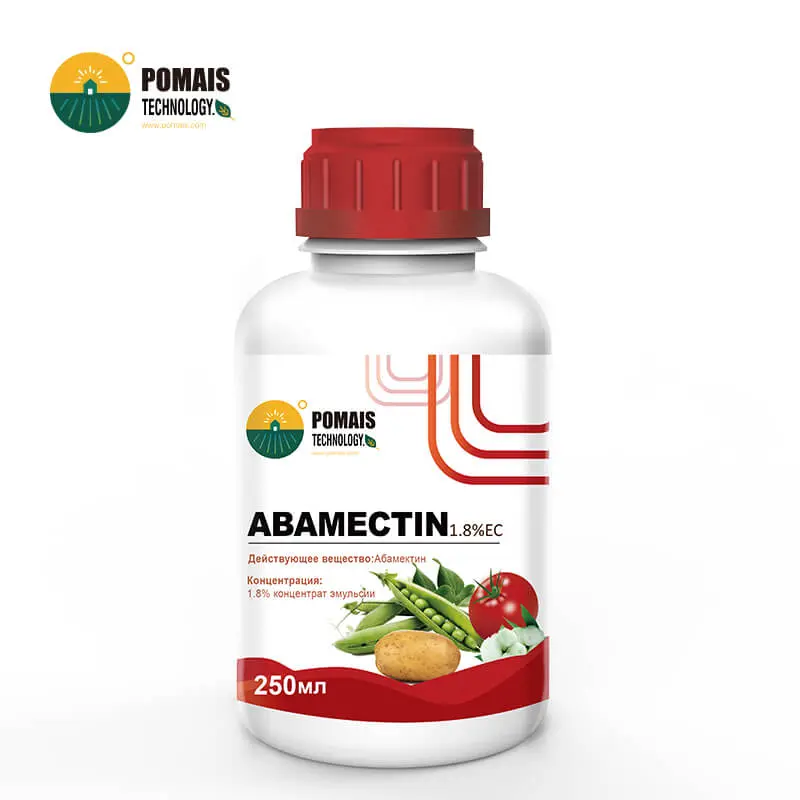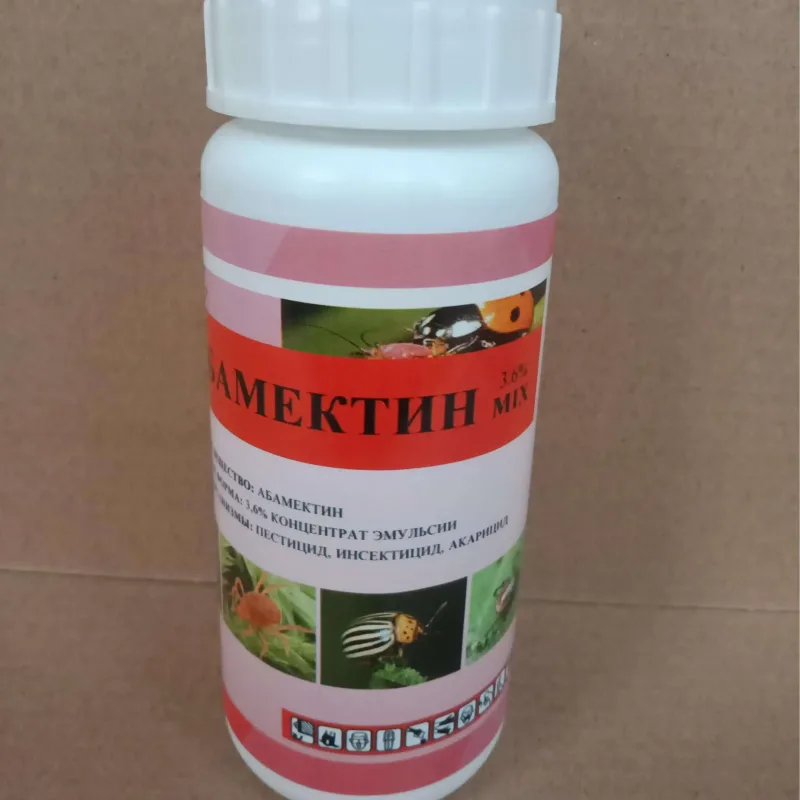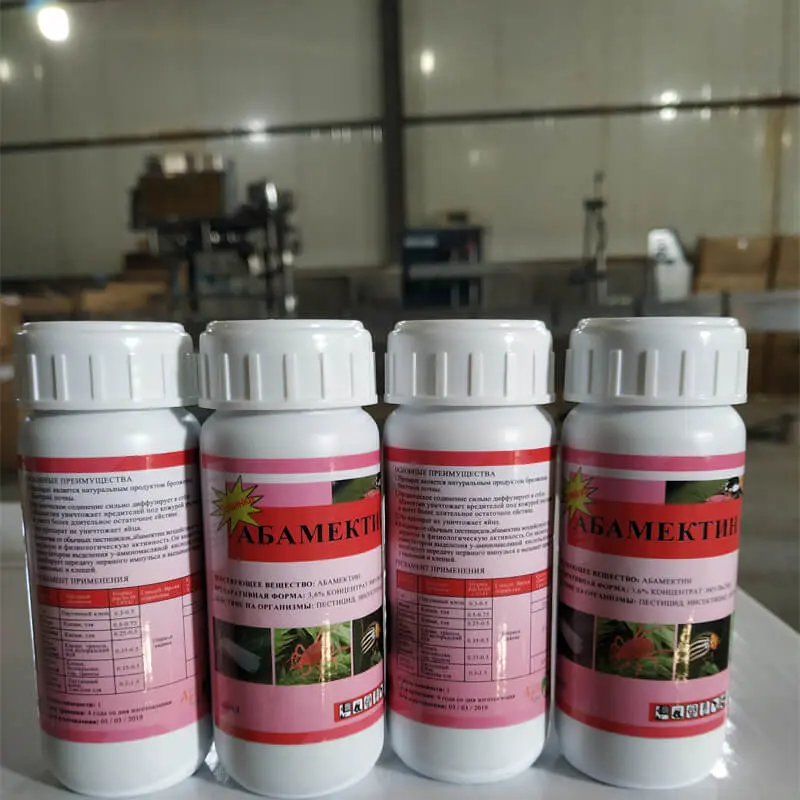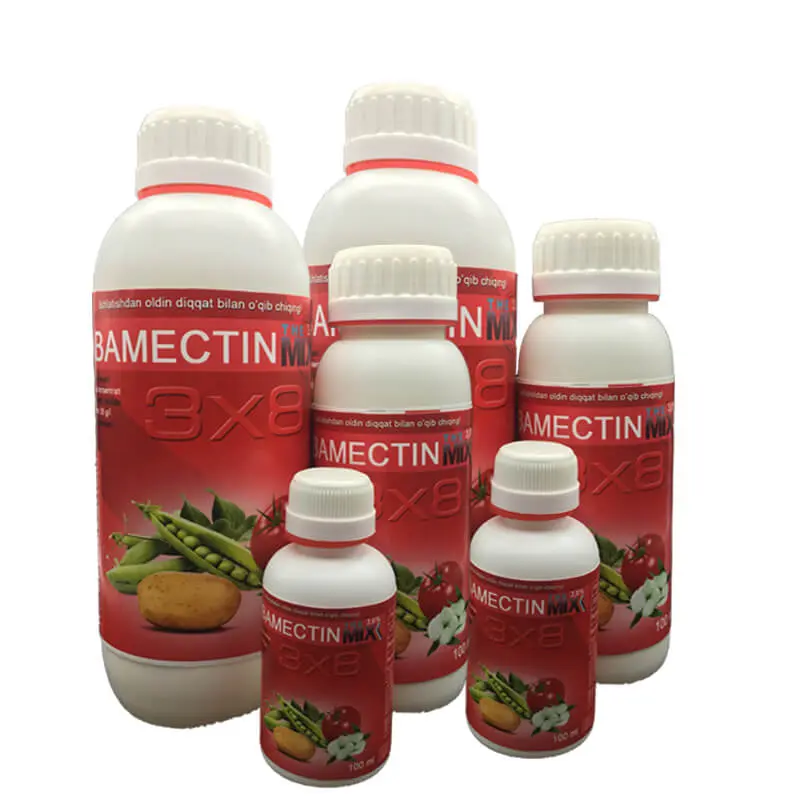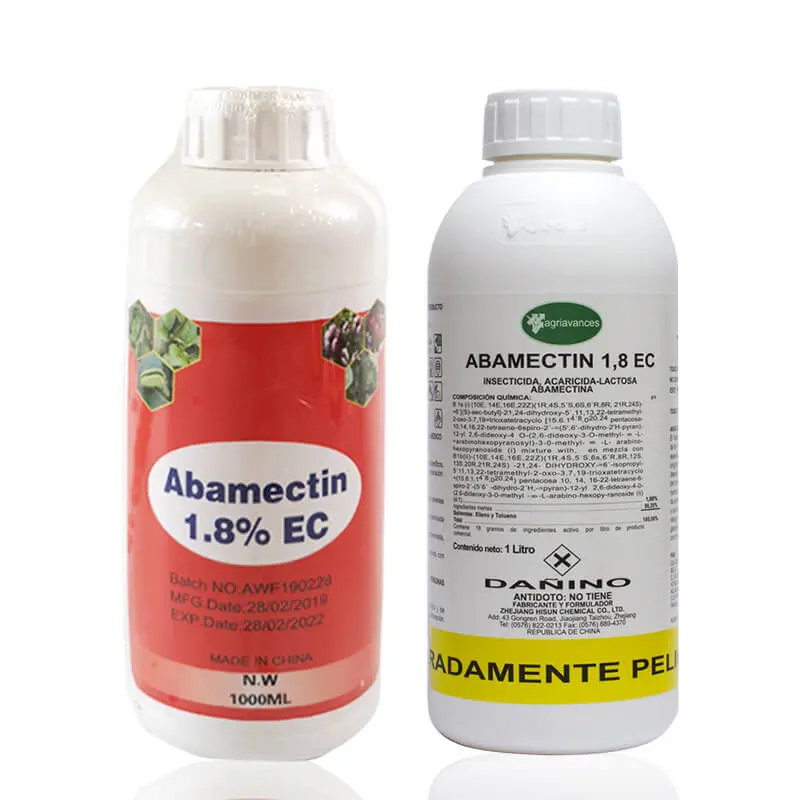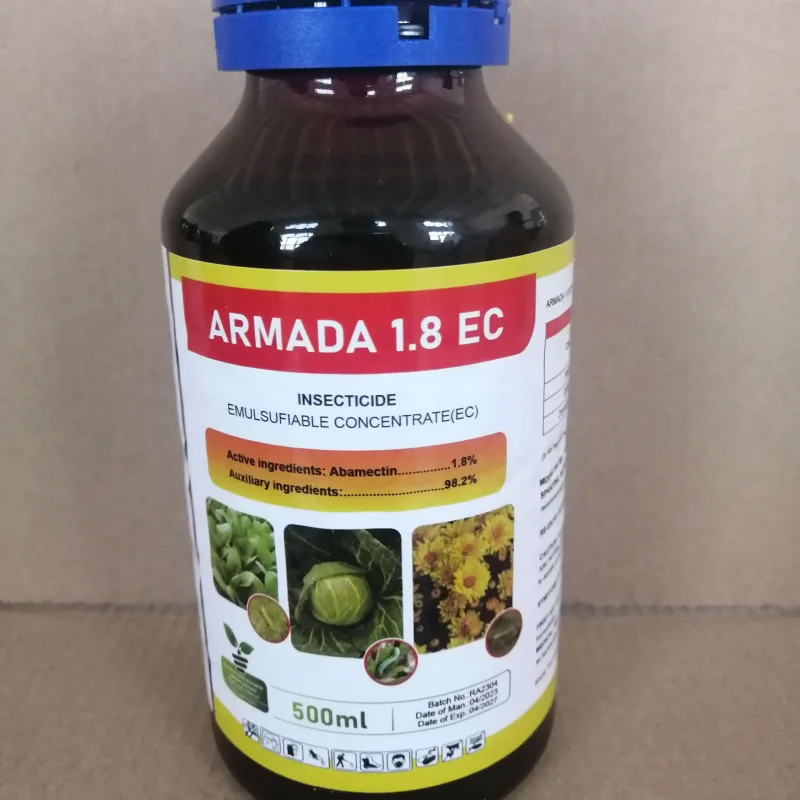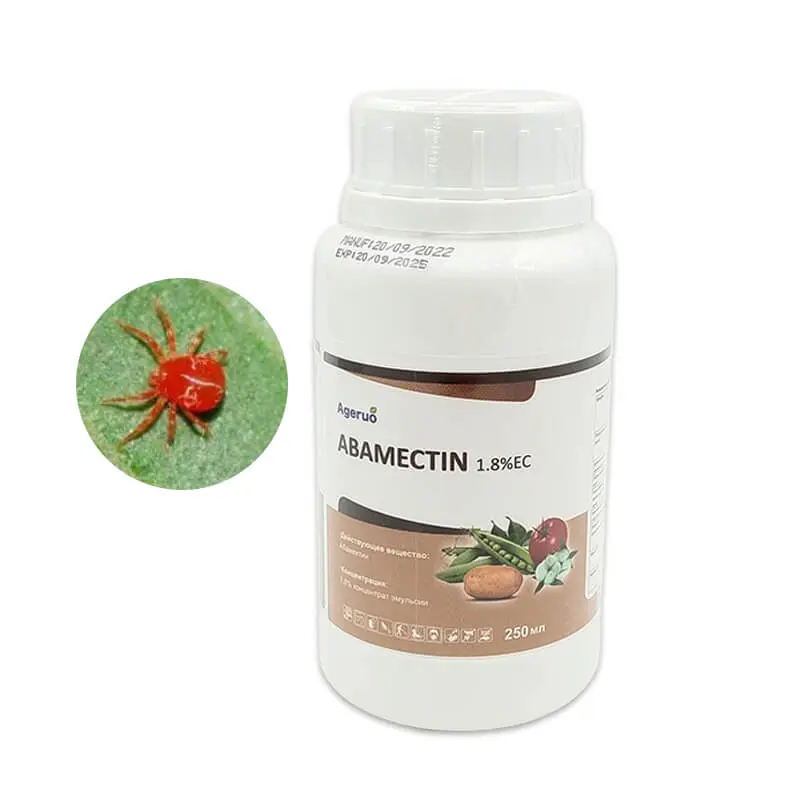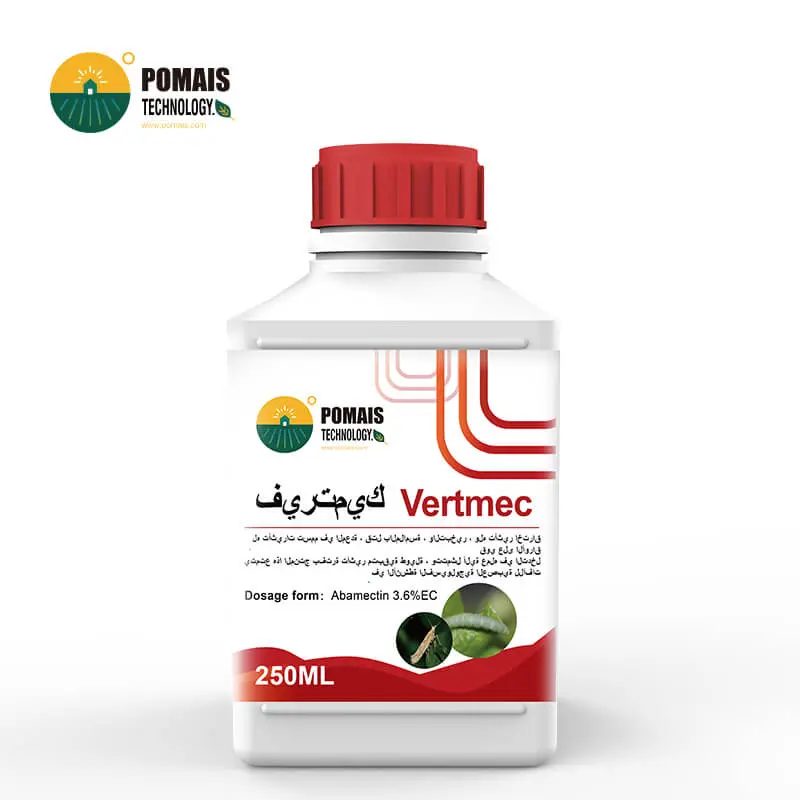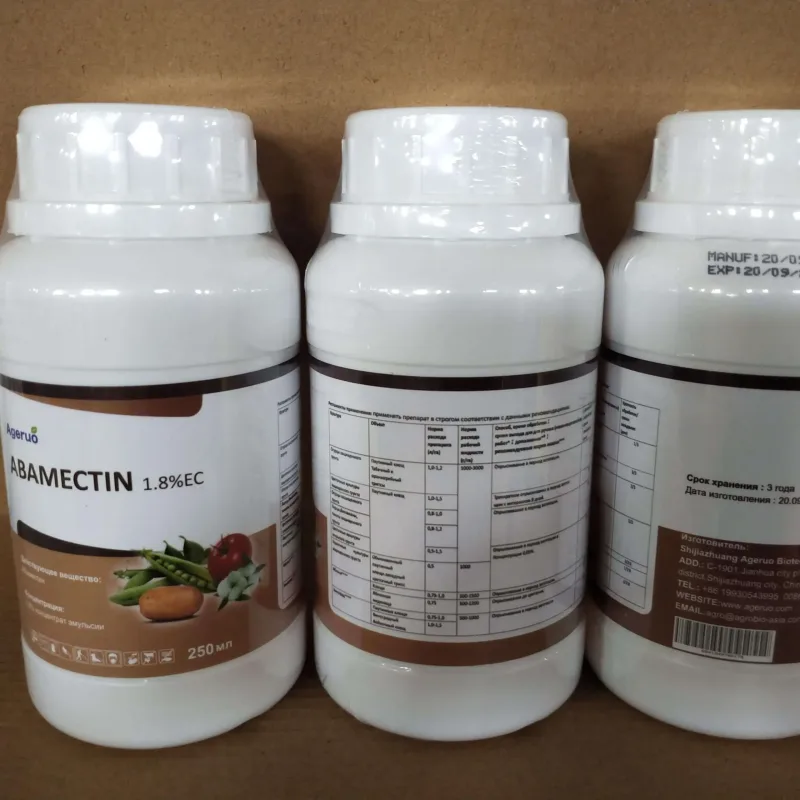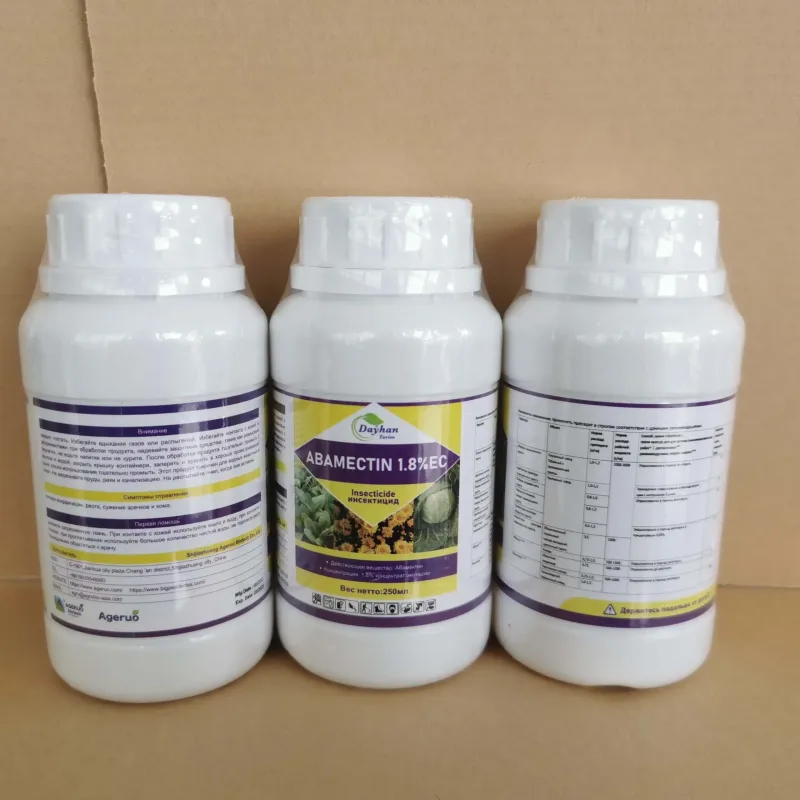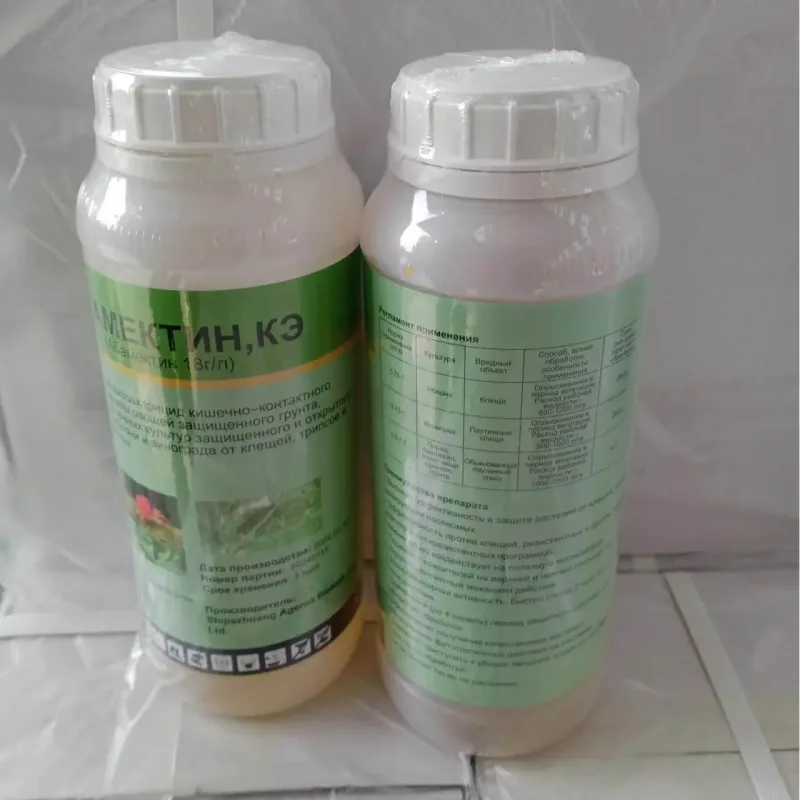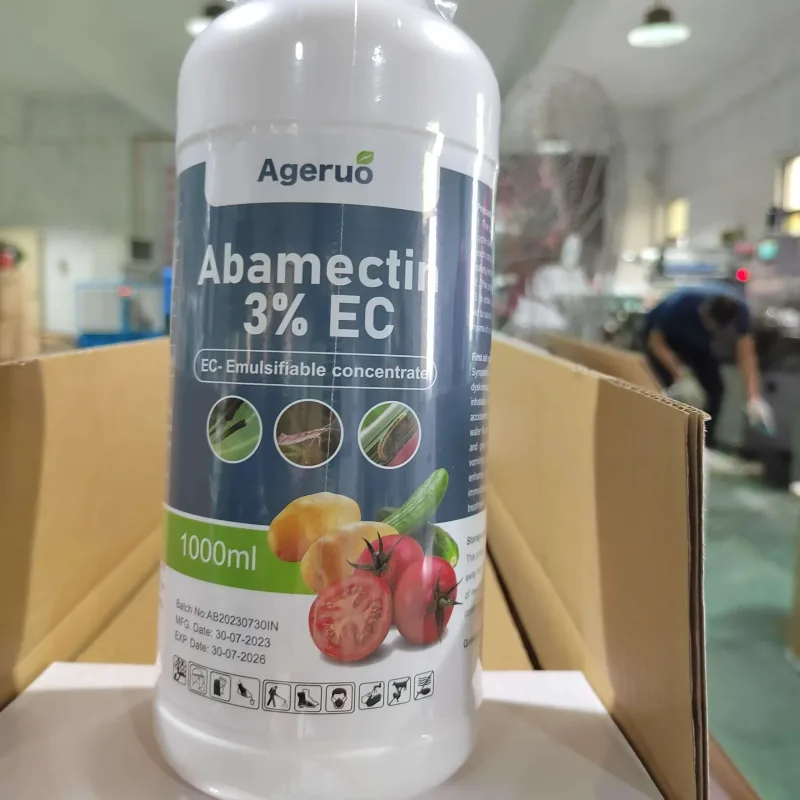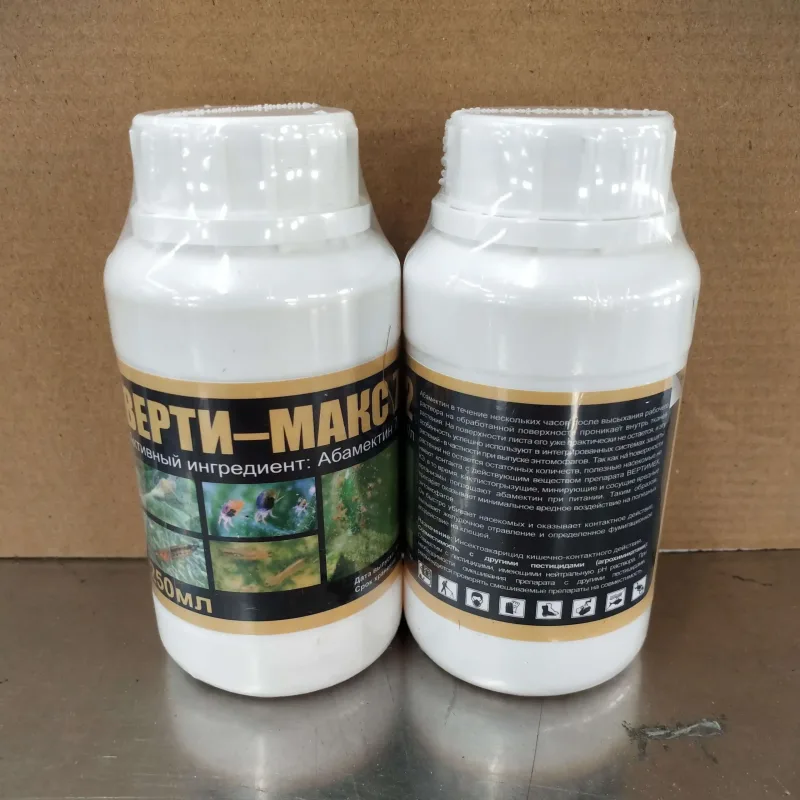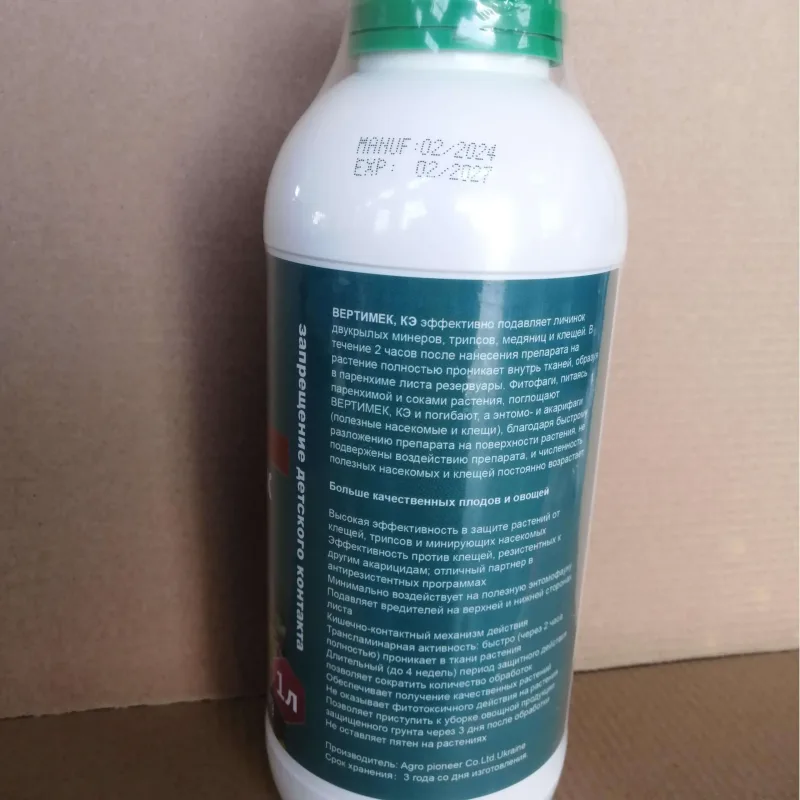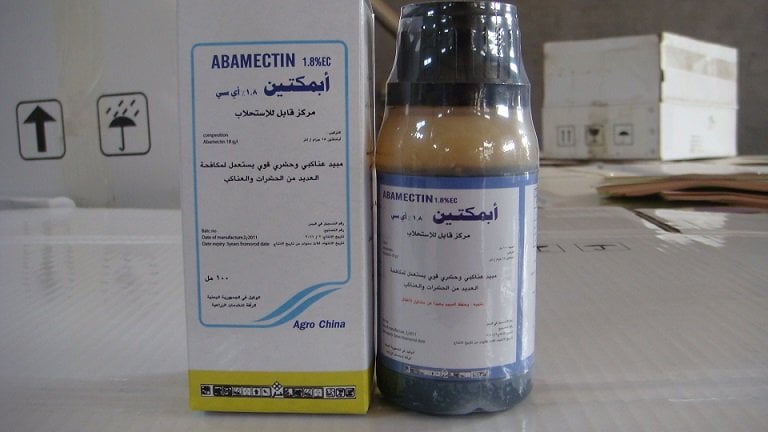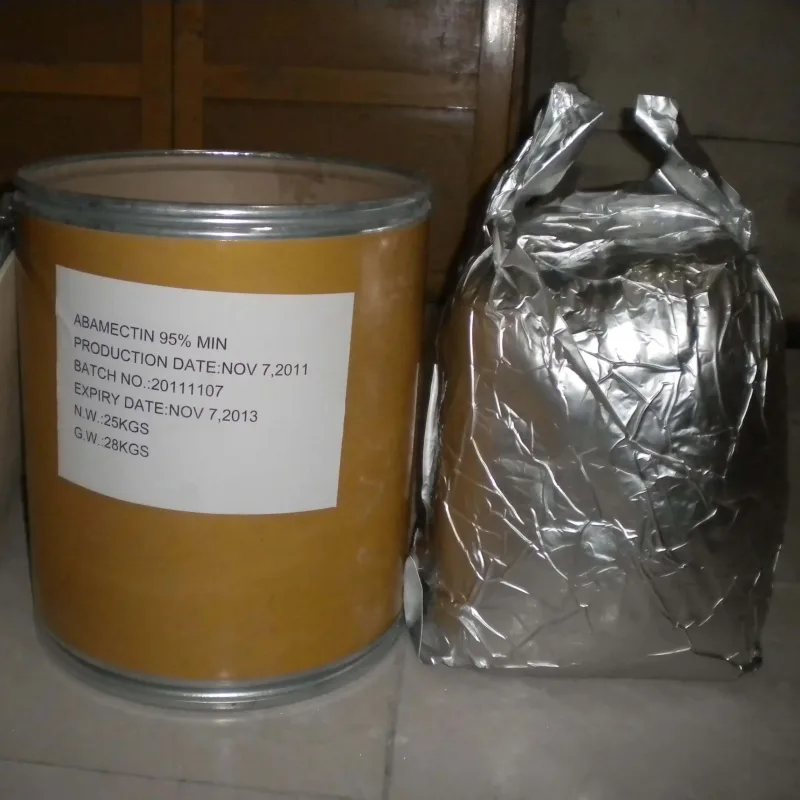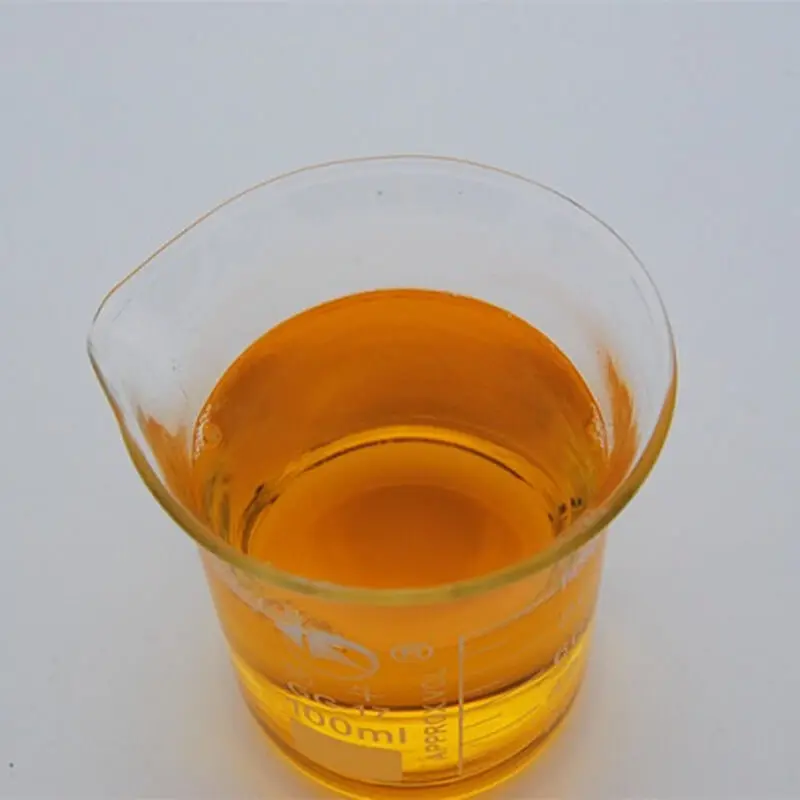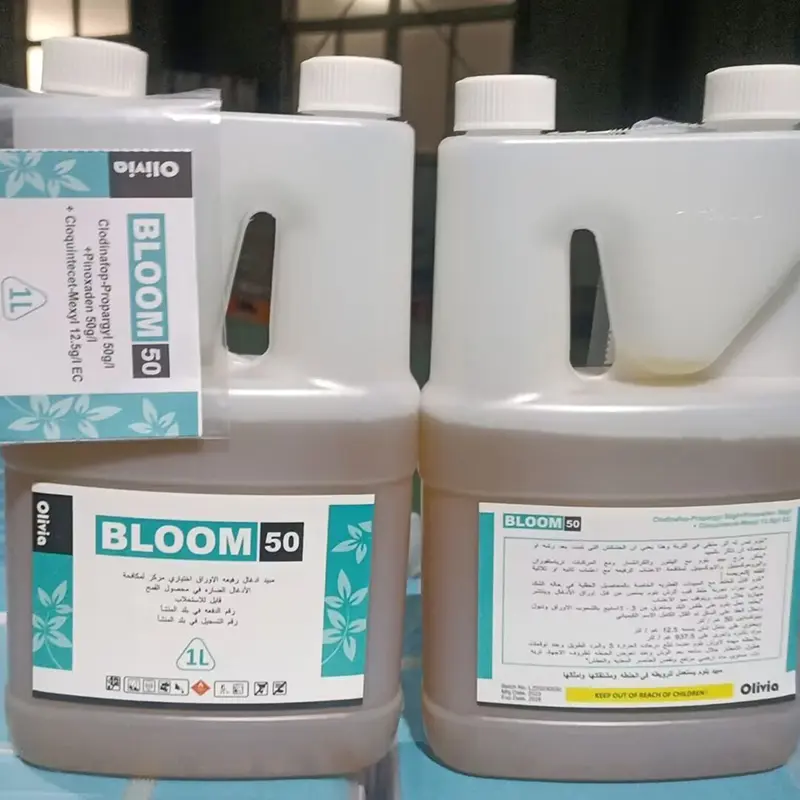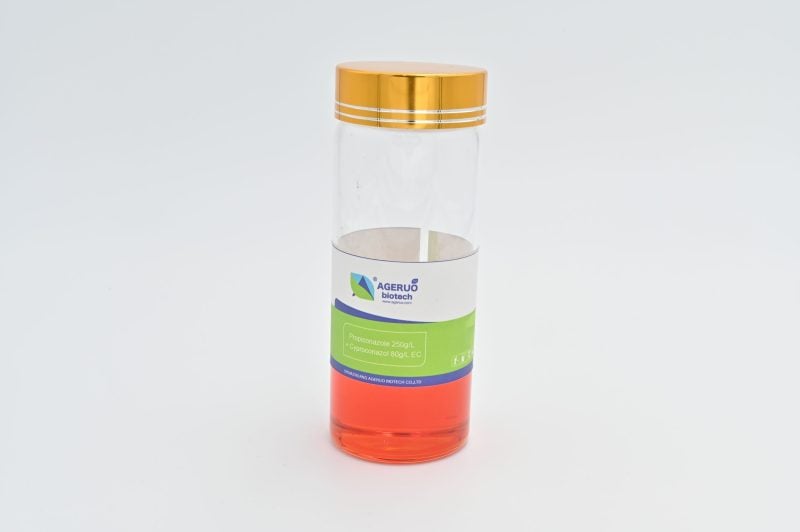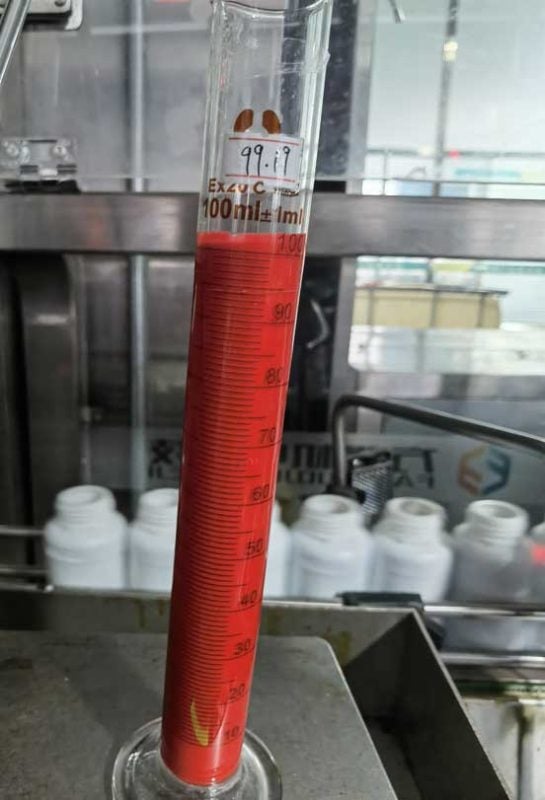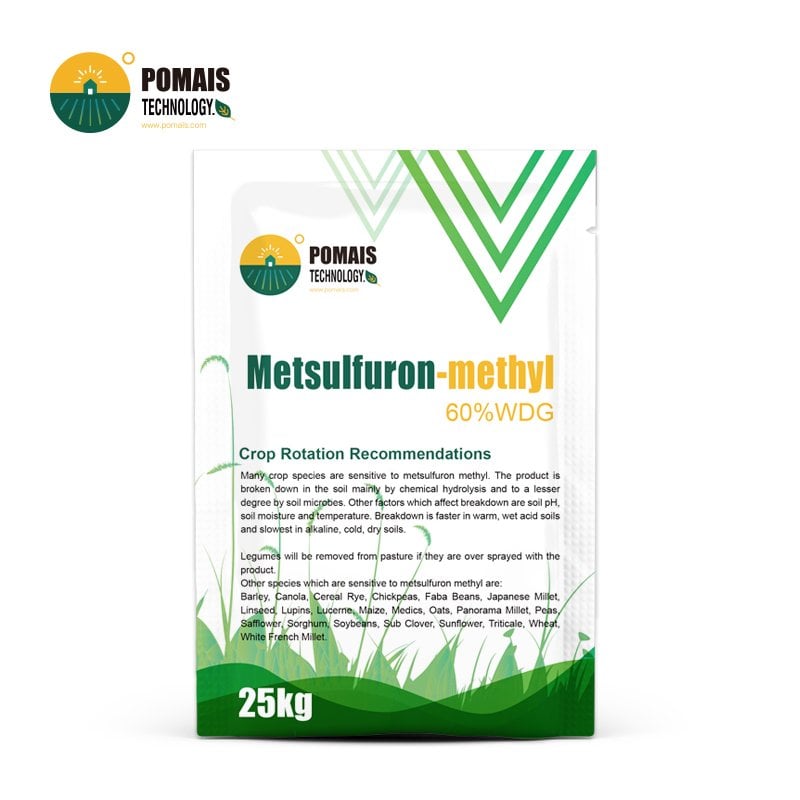Abamectin 18g/l EC Insecticide | Ant Bait | Miticide
Abamectin 18g/l EC is a highly effective insecticide and miticide that belongs to the avermectin class, derived from the natural fermentation of the bacterium Streptomyces avermitilis. It is widely used in agriculture, horticulture, and pest control for managing a broad range of insects and mites. Abamectin works primarily through contact and ingestion, targeting the nervous system of pests and causing paralysis and death.
- Designed for Professional Buyers & Bulk Orders
- This product is available for business purchase and large-scale distribution.
- We support custom packaging, labeling, and formulation to meet your market needs.
- Let’s build your brand together.

About Abamectin 18g/l EC Insecticide | Ant Bait | Miticide
About Abamectin 18g/l EC Insecticide | Ant Bait | Miticide
| Product Name | Abamectin (insecticide/nematicide) |
| Active Ingredient | Abamectin |
| CAS Number | 71751-41-2 |
| Molecular Formula | C48H72O14 |
| Target Pests | Spider mites, aphids, whiteflies, thrips, ants, roaches, nematodes |
| Applicable Uses | Agricultural pest control, veterinary applications for livestock |
| Dosage | Varies by application: 0.5-1.0 L/ha for crops; 0.5-1.5 ml per 10 L for ants |
| Mode of Action | Systemic insecticide; disrupts nerve function by enhancing the release of neurotransmitters |
| Common Formulations | 18g/L EC, 36g/L EC, 50g/L EC, 30g/L EC, 32g/L EC, 35%WDG, 40%WDG, 200g/L SC, 95%TC |
| Packaging Types | 100ml, 500ml, 1L bottles for EC |
| Product Keywords | Abamectin insecticide, Abamectin products, Abamectin pesticide, Abamectin nematicide, buy Abamectin, Abamectin price |
| Safety & Toxicity | Abamectin is generally safe when used as directed; caution is advised around pets and livestock; not recommended for use on certain animals without veterinary guidance |
| Veterinary Uses | Abamectin for cattle, Abamectin for dogs |
| Systemic vs Contact | Abamectin is primarily systemic but can have contact activity |
| Comparisons | Abamectin vs borax, Abamectin and ivermectin |
| Company Strengths | POMAIS offers high-quality Abamectin formulations for effective pest control, supports OEM/ODM services, and provides competitive pricing and custom packaging solutions for various applications |
We is committed to providing high-quality Abamectin products for effective pest management. Our production facilities are ISO 9001:2000, ensuring premium quality. We offer registration support and ICAMA certificates to meet international standards.
Abamectin Insecticide | Ant Bait | Miticide
Abamectin is a biopesticide extracted from bacterial fermentation products with broad-spectrum effects of bactericide, insecticide and acaricide. This low-toxicity pesticide is approved for use in many countries and is widely popular because it has a low environmental impact and does not easily accumulate in the soil. Abamectin 1.8% EC is a popular formulation on the market today for use on a variety of crops, including ornamentals, fruit trees, vegetables, cotton and more.
Mode of Action:
Abamectin works by activating glutamate-gated chloride channels in the nerve and muscle cells of insects and mites. This causes the cells to remain open, leading to paralysis and death of the pests. It is effective through contact and ingestion, making it ideal for sucking and chewing insects and mites.
Once exposed, pests stop feeding within hours, although they may take several days to die, depending on the pest species.
Benefits
- Effective Control: Provides reliable control against a wide range of insects and nematodes.
- Systemic Action: Penetrates plant tissues, offering long-lasting protection.
- Versatile Use: Suitable for various crops, including vegetables, fruits, and ornamentals.
- Low Toxicity: Generally low toxicity to beneficial insects when used according to recommended guidelines.
Applications
| Crops/Areas | Target Pests | Rate/ha | Critical Comments |
|---|---|---|---|
| Vegetables | Spider mites, aphids, thrips, leafminers | 200-400 ml/ha | Apply as a foliar spray or drench. Reapply as needed based on pest pressure. |
| Fruit Trees | Mites, leafminers, thrips | 250-500 ml/ha | Effective in orchards; use during early pest activity for best results. |
| Field Crops | Nematodes, cutworms, aphids | 300-600 ml/ha | Use in crops like corn, cotton, and soybeans. Incorporate into soil for nematode control. |
| Ornamentals | Spider mites, thrips, aphids | 150-300 ml/ha | Safe for most ornamental plants; apply as needed for pest management. |
Usage:
Abamectin is very easy to formulate, just pour the agent into water with a little mixing and use it. This method is not only simple but also safe for the crop and is especially suitable for use during peak periods when pests are a problem.
Application Method:
Foliar Spray: Abamectin is applied as a foliar spray, with special attention to ensure the spray covers both the top and bottom of leaves where mites typically feed.
Translaminar Action: Its translaminar activity allows the product to move through the leaf tissue, reaching mites feeding on the undersides of leaves.
Repeat Applications: Depending on the level of infestation, it may be necessary to reapply after 7-14 days, especially if mites persist or reinfest the crop.
Scope of application:
Fruit trees: citrus, pear, tomato, watermelon, etc.
Vegetables: eggplants, cucurbits, beans
Ornamentals and cotton
Target Pests:
Aphids
Leafminers
Thrips
Whiteflies
Caterpillars
Leafhoppers
Main Crop Applications:
Fruits and Vegetables: Abamectin is commonly used in crops such as tomatoes, cucumbers, peppers, and lettuce to control sucking pests like aphids and whiteflies.
Ornamentals: It is also effective in ornamental plants to control leafminers, thrips, and mites.
Tree Crops: Used in citrus, apples, pears, and avocados for controlling mites, leafminers, and thrips.
Safety Tip:
Abamectin emulsion is a low-toxicity product, but it needs to be stored and transported under strict regulations and avoided in humid places.
Avoid sunlight and mixing with food, seeds and beverages.
Avoid direct skin and eye contact and wear appropriate protective equipment when using.
Application Rates and Usage
- Vegetables: Use 200-400 ml/ha to control pests like spider mites and aphids. Apply as a foliar spray.
- Fruit Trees: Apply 250-500 ml/ha for effective control of mites and leafminers. Timing is critical for early season application.
- Field Crops: Utilize 300-600 ml/ha for controlling nematodes and cutworms. Incorporate into the soil where applicable.
- Ornamentals: For spider mites and thrips, apply 150-300 ml/ha as needed for pest control.
Always follow product label instructions for proper application rates and safety guidelines.
Packaging Options
- Bulk Packaging: Available in 200L drums, 1000L IBC containers, ideal for large-scale agricultural and industrial use.
- Small Packaging: Available in 5L, 1L, and 500ml containers for smaller applications in horticulture and residential use.
Abamectina FAQ
- What is abamectin?
La abamectina es un insecticida y acaricida derivado de las avermectinas, compuestos naturales producidos por bacterias del suelo. - What is abamectin used for?
Abamectin is used to control a variety of pests, including mites, aphids, thrips, and whiteflies in agricultural crops, and as a bait for ants and cockroaches. - Is abamectin systemic?
Abamectin has limited systemic properties but primarily acts as a contact and stomach poison when pests ingest or come into direct contact with it. - Abamectin contact or systemic:
Abamectin works mainly as a contact insecticide but has minor systemic effects in some plants. - Abamectin mode of action:
Abamectin works by disrupting the nervous system of pests, causing paralysis and death by binding to glutamate-gated chloride channels. - How does abamectin work?
It targets the nervous system of insects and mites, leading to paralysis and eventual death. It is effective after ingestion or direct contact. - Abamectin uses in agriculture:
Abamectin is used on crops like fruits, vegetables, and ornamental plants to control pests such as mites, thrips, aphids, and whiteflies. - How to use abamectin:
Dilute abamectin according to the product label and apply it as a foliar spray or as bait, depending on the target pest. - How to use abamectin for ants:
Abamectin ant bait should be applied near ant trails or nests. The ants carry the bait back to the colony, eventually killing the queen and colony members. - How to use abamectin spray for spider mites:
Spray abamectin evenly on plants, targeting areas where spider mites are present. Ensure thorough coverage on the underside of leaves, where mites typically hide.
Specific Pests & Uses:
- Abamectin ant bait:
Used to attract ants that then carry the bait back to their colony, effectively eliminating the colony over time. - Abamectin for roaches:
Abamectin can be used in bait formulations to control cockroach populations by ingestion. - Abamectin for spider mites:
Abamectin is highly effective against spider mites, causing paralysis and death shortly after exposure. - Abamectin aphids:
Abamectin can be used to control aphids on crops by spraying directly onto the infested plants. - Abamectin cockroach:
It is used as a bait to control cockroach infestations. - Abamectin roach bait:
Formulated into bait gels that cockroaches consume, leading to the collapse of the colony. - Abamectin gel bait:
Gel formulations are commonly used for ants and cockroaches, placed in areas of high pest activity. - Abamectin spider mites:
It is effective against spider mites, providing control through direct contact and ingestion. - Abamectin whitefly:
Abamectin is effective in controlling whiteflies, which are common pests in greenhouse and field crops. - Abamectin thrips:
Used to control thrips by applying the product to the foliage of affected plants. - Abamectin for cattle:
Abamectin is used as a dewormer in cattle to control internal and external parasites. - Abamectin nematode control:
While not primarily a nematicide, abamectin may have some effectiveness against certain nematodes in crops. - Abamectin carpenter ants:
It is used in bait formulations to control carpenter ants, which take the bait back to their colonies. - Abamectin bermudagrass mites:
Abamectin is effective in controlling bermudagrass mites when applied as a foliar spray.
Safety & Toxicity:
- Abamectin safety:
Abamectin is generally safe when used according to label instructions, but it can be toxic if ingested or if exposure levels are too high. - Abamectin side effects:
Possible side effects include skin and eye irritation. In high doses, it may cause neurological symptoms in humans and animals. - Is abamectin safe?
Yes, when used as directed, abamectin is safe for humans, animals, and the environment, but caution should be exercised to avoid excessive exposure. - Is abamectin toxic to dogs?
Yes, abamectin can be toxic to dogs if ingested in large amounts. Symptoms of poisoning include lethargy, tremors, and in severe cases, death. - Is abamectin toxic to humans?
Abamectin is low in toxicity to humans when used properly, but excessive exposure can cause nausea, vomiting, dizziness, and neurological symptoms.
Animals & Veterinary Use:
- Abamectin for dogs:
It is sometimes used to treat mites in dogs but should only be applied under veterinary supervision due to potential toxicity. - Abamectina bovinos:
Abamectina se utiliza en bovinos para controlar parásitos internos y externos, incluidos gusanos intestinales, ácaros y garrapatas.
| Product Name | Abamectin (insecticide/nematicide) |
| Active Ingredient | Abamectin |
| CAS Number | 71751-41-2 |
| Molecular Formula | C48H72O14 |
| Target Pests | Spider mites, aphids, whiteflies, thrips, ants, roaches, nematodes |
| Applicable Uses | Agricultural pest control, veterinary applications for livestock |
| Dosage | Varies by application: 0.5-1.0 L/ha for crops; 0.5-1.5 ml per 10 L for ants |
| Mode of Action | Systemic insecticide; disrupts nerve function by enhancing the release of neurotransmitters |
| Common Formulations | 18g/L EC, 36g/L EC, 50g/L EC, 30g/L EC, 32g/L EC, 35%WDG, 40%WDG, 200g/L SC, 95%TC |
| Packaging Types | 100ml, 500ml, 1L bottles for EC |
| Product Keywords | Abamectin insecticide, Abamectin products, Abamectin pesticide, Abamectin nematicide, buy Abamectin, Abamectin price |
| Safety & Toxicity | Abamectin is generally safe when used as directed; caution is advised around pets and livestock; not recommended for use on certain animals without veterinary guidance |
| Veterinary Uses | Abamectin for cattle, Abamectin for dogs |
| Systemic vs Contact | Abamectin is primarily systemic but can have contact activity |
| Comparisons | Abamectin vs borax, Abamectin and ivermectin |
| Company Strengths | POMAIS offers high-quality Abamectin formulations for effective pest control, supports OEM/ODM services, and provides competitive pricing and custom packaging solutions for various applications |
We is committed to providing high-quality Abamectin products for effective pest management. Our production facilities are ISO 9001:2000, ensuring premium quality. We offer registration support and ICAMA certificates to meet international standards.
Abamectin Insecticide | Ant Bait | Miticide
Abamectin is a biopesticide extracted from bacterial fermentation products with broad-spectrum effects of bactericide, insecticide and acaricide. This low-toxicity pesticide is approved for use in many countries and is widely popular because it has a low environmental impact and does not easily accumulate in the soil. Abamectin 1.8% EC is a popular formulation on the market today for use on a variety of crops, including ornamentals, fruit trees, vegetables, cotton and more.
Mode of Action:
Abamectin works by activating glutamate-gated chloride channels in the nerve and muscle cells of insects and mites. This causes the cells to remain open, leading to paralysis and death of the pests. It is effective through contact and ingestion, making it ideal for sucking and chewing insects and mites.
Once exposed, pests stop feeding within hours, although they may take several days to die, depending on the pest species.
Benefits
- Effective Control: Provides reliable control against a wide range of insects and nematodes.
- Systemic Action: Penetrates plant tissues, offering long-lasting protection.
- Versatile Use: Suitable for various crops, including vegetables, fruits, and ornamentals.
- Low Toxicity: Generally low toxicity to beneficial insects when used according to recommended guidelines.
Applications
| Crops/Areas | Target Pests | Rate/ha | Critical Comments |
|---|---|---|---|
| Vegetables | Spider mites, aphids, thrips, leafminers | 200-400 ml/ha | Apply as a foliar spray or drench. Reapply as needed based on pest pressure. |
| Fruit Trees | Mites, leafminers, thrips | 250-500 ml/ha | Effective in orchards; use during early pest activity for best results. |
| Field Crops | Nematodes, cutworms, aphids | 300-600 ml/ha | Use in crops like corn, cotton, and soybeans. Incorporate into soil for nematode control. |
| Ornamentals | Spider mites, thrips, aphids | 150-300 ml/ha | Safe for most ornamental plants; apply as needed for pest management. |
Usage:
Abamectin is very easy to formulate, just pour the agent into water with a little mixing and use it. This method is not only simple but also safe for the crop and is especially suitable for use during peak periods when pests are a problem.
Application Method:
Foliar Spray: Abamectin is applied as a foliar spray, with special attention to ensure the spray covers both the top and bottom of leaves where mites typically feed.
Translaminar Action: Its translaminar activity allows the product to move through the leaf tissue, reaching mites feeding on the undersides of leaves.
Repeat Applications: Depending on the level of infestation, it may be necessary to reapply after 7-14 days, especially if mites persist or reinfest the crop.
Scope of application:
Fruit trees: citrus, pear, tomato, watermelon, etc.
Vegetables: eggplants, cucurbits, beans
Ornamentals and cotton
Target Pests:
Aphids
Leafminers
Thrips
Whiteflies
Caterpillars
Leafhoppers
Main Crop Applications:
Fruits and Vegetables: Abamectin is commonly used in crops such as tomatoes, cucumbers, peppers, and lettuce to control sucking pests like aphids and whiteflies.
Ornamentals: It is also effective in ornamental plants to control leafminers, thrips, and mites.
Tree Crops: Used in citrus, apples, pears, and avocados for controlling mites, leafminers, and thrips.
Safety Tip:
Abamectin emulsion is a low-toxicity product, but it needs to be stored and transported under strict regulations and avoided in humid places.
Avoid sunlight and mixing with food, seeds and beverages.
Avoid direct skin and eye contact and wear appropriate protective equipment when using.
Application Rates and Usage
- Vegetables: Use 200-400 ml/ha to control pests like spider mites and aphids. Apply as a foliar spray.
- Fruit Trees: Apply 250-500 ml/ha for effective control of mites and leafminers. Timing is critical for early season application.
- Field Crops: Utilize 300-600 ml/ha for controlling nematodes and cutworms. Incorporate into the soil where applicable.
- Ornamentals: For spider mites and thrips, apply 150-300 ml/ha as needed for pest control.
Always follow product label instructions for proper application rates and safety guidelines.
Packaging Options
- Bulk Packaging: Available in 200L drums, 1000L IBC containers, ideal for large-scale agricultural and industrial use.
- Small Packaging: Available in 5L, 1L, and 500ml containers for smaller applications in horticulture and residential use.
Abamectina FAQ
- What is abamectin?
La abamectina es un insecticida y acaricida derivado de las avermectinas, compuestos naturales producidos por bacterias del suelo. - What is abamectin used for?
Abamectin is used to control a variety of pests, including mites, aphids, thrips, and whiteflies in agricultural crops, and as a bait for ants and cockroaches. - Is abamectin systemic?
Abamectin has limited systemic properties but primarily acts as a contact and stomach poison when pests ingest or come into direct contact with it. - Abamectin contact or systemic:
Abamectin works mainly as a contact insecticide but has minor systemic effects in some plants. - Abamectin mode of action:
Abamectin works by disrupting the nervous system of pests, causing paralysis and death by binding to glutamate-gated chloride channels. - How does abamectin work?
It targets the nervous system of insects and mites, leading to paralysis and eventual death. It is effective after ingestion or direct contact. - Abamectin uses in agriculture:
Abamectin is used on crops like fruits, vegetables, and ornamental plants to control pests such as mites, thrips, aphids, and whiteflies. - How to use abamectin:
Dilute abamectin according to the product label and apply it as a foliar spray or as bait, depending on the target pest. - How to use abamectin for ants:
Abamectin ant bait should be applied near ant trails or nests. The ants carry the bait back to the colony, eventually killing the queen and colony members. - How to use abamectin spray for spider mites:
Spray abamectin evenly on plants, targeting areas where spider mites are present. Ensure thorough coverage on the underside of leaves, where mites typically hide.
Specific Pests & Uses:
- Abamectin ant bait:
Used to attract ants that then carry the bait back to their colony, effectively eliminating the colony over time. - Abamectin for roaches:
Abamectin can be used in bait formulations to control cockroach populations by ingestion. - Abamectin for spider mites:
Abamectin is highly effective against spider mites, causing paralysis and death shortly after exposure. - Abamectin aphids:
Abamectin can be used to control aphids on crops by spraying directly onto the infested plants. - Abamectin cockroach:
It is used as a bait to control cockroach infestations. - Abamectin roach bait:
Formulated into bait gels that cockroaches consume, leading to the collapse of the colony. - Abamectin gel bait:
Gel formulations are commonly used for ants and cockroaches, placed in areas of high pest activity. - Abamectin spider mites:
It is effective against spider mites, providing control through direct contact and ingestion. - Abamectin whitefly:
Abamectin is effective in controlling whiteflies, which are common pests in greenhouse and field crops. - Abamectin thrips:
Used to control thrips by applying the product to the foliage of affected plants. - Abamectin for cattle:
Abamectin is used as a dewormer in cattle to control internal and external parasites. - Abamectin nematode control:
While not primarily a nematicide, abamectin may have some effectiveness against certain nematodes in crops. - Abamectin carpenter ants:
It is used in bait formulations to control carpenter ants, which take the bait back to their colonies. - Abamectin bermudagrass mites:
Abamectin is effective in controlling bermudagrass mites when applied as a foliar spray.
Safety & Toxicity:
- Abamectin safety:
Abamectin is generally safe when used according to label instructions, but it can be toxic if ingested or if exposure levels are too high. - Abamectin side effects:
Possible side effects include skin and eye irritation. In high doses, it may cause neurological symptoms in humans and animals. - Is abamectin safe?
Yes, when used as directed, abamectin is safe for humans, animals, and the environment, but caution should be exercised to avoid excessive exposure. - Is abamectin toxic to dogs?
Yes, abamectin can be toxic to dogs if ingested in large amounts. Symptoms of poisoning include lethargy, tremors, and in severe cases, death. - Is abamectin toxic to humans?
Abamectin is low in toxicity to humans when used properly, but excessive exposure can cause nausea, vomiting, dizziness, and neurological symptoms.
Animals & Veterinary Use:
- Abamectin for dogs:
It is sometimes used to treat mites in dogs but should only be applied under veterinary supervision due to potential toxicity. - Abamectina bovinos:
Abamectina se utiliza en bovinos para controlar parásitos internos y externos, incluidos gusanos intestinales, ácaros y garrapatas.
Related Products
Latest News

